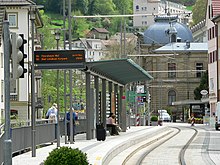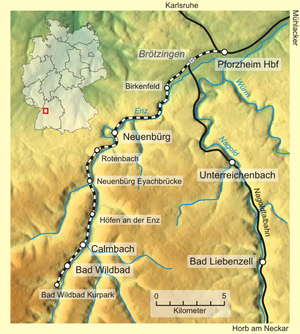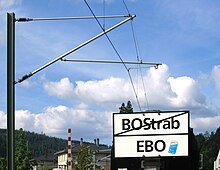Enz Valley Railway
| Pforzheim-Brötzingen-Bad Wildbad | |||||||||||||||||||||||||||||||||||||||||||||||||||||||||||||||||||||||||||||||||||||||||||||||||||||||||
|---|---|---|---|---|---|---|---|---|---|---|---|---|---|---|---|---|---|---|---|---|---|---|---|---|---|---|---|---|---|---|---|---|---|---|---|---|---|---|---|---|---|---|---|---|---|---|---|---|---|---|---|---|---|---|---|---|---|---|---|---|---|---|---|---|---|---|---|---|---|---|---|---|---|---|---|---|---|---|---|---|---|---|---|---|---|---|---|---|---|---|---|---|---|---|---|---|---|---|---|---|---|---|---|---|---|
| Route number (DB) : | 4851 | ||||||||||||||||||||||||||||||||||||||||||||||||||||||||||||||||||||||||||||||||||||||||||||||||||||||||
| Course book section (DB) : | 710.6, formerly 302a, formerly 304c |
||||||||||||||||||||||||||||||||||||||||||||||||||||||||||||||||||||||||||||||||||||||||||||||||||||||||
| Route length: |
EBO : 20.037 km + BOStrab : 0.84 km |
||||||||||||||||||||||||||||||||||||||||||||||||||||||||||||||||||||||||||||||||||||||||||||||||||||||||
| Gauge : | 1435 mm ( standard gauge ) | ||||||||||||||||||||||||||||||||||||||||||||||||||||||||||||||||||||||||||||||||||||||||||||||||||||||||
| Route class : | C2 | ||||||||||||||||||||||||||||||||||||||||||||||||||||||||||||||||||||||||||||||||||||||||||||||||||||||||
| Power system : | from Bad Wildbad system limit: 750 volts = | ||||||||||||||||||||||||||||||||||||||||||||||||||||||||||||||||||||||||||||||||||||||||||||||||||||||||
| Power system : | to Bad Wildbad system limit: 15 kV 16.7 Hz ~ | ||||||||||||||||||||||||||||||||||||||||||||||||||||||||||||||||||||||||||||||||||||||||||||||||||||||||
| Maximum slope : | 12 ‰ | ||||||||||||||||||||||||||||||||||||||||||||||||||||||||||||||||||||||||||||||||||||||||||||||||||||||||
| Minimum radius : | 190 m | ||||||||||||||||||||||||||||||||||||||||||||||||||||||||||||||||||||||||||||||||||||||||||||||||||||||||
| Top speed: | 80 km / h | ||||||||||||||||||||||||||||||||||||||||||||||||||||||||||||||||||||||||||||||||||||||||||||||||||||||||
|
|||||||||||||||||||||||||||||||||||||||||||||||||||||||||||||||||||||||||||||||||||||||||||||||||||||||||
The Enztalbahn , also known as the Enzbahn for short , is a 19.76 kilometer long railway line in the northern Black Forest, which largely follows the Enz River . The continuous single-track main line branches in Pforzheim district Brötzingen of the Nagold Valley Railway and performs as a spur track to Bad Wildbad , until 1992 called Wildbad. Until 2002 it was a non- electrified route with little traffic significance . After the takeover by the Albtal-Verkehrs-Gesellschaft (AVG), the expansion to a tram line and the construction of a 1.03 kilometer long tram connection line to the city center of Bad Wildbad, the timetable was condensed and the number of passengers increased significantly.
course
From the junction of the Nagoldtalbahn to the Brötzingen Wohnlichstraße stop , the Enzalbahn runs within the boundaries of the city of Pforzheim, from Birkenfeld to the Eyachbrücke it crosses the Enzkreis , the rest of the route runs in the Calw district . With Pforzheim, Birkenfeld, Neuenbürg , Höfen an der Enz and Bad Wildbad a total of five communities are passed.
All trains to and from Bad Wildbad start and end at Pforzheim Central Station . As far as Brötzingen Mitte station, they use the tracks of the Nagold Valley Railway, which is now double-tracked in this section. Previously, the two railway lines in the city of Pforzheim were two parallel single-track lines that were operationally independent of each other.
From Brötzingen the route follows the valley of the Enz via Birkenfeld, Neuenbürg, Höfen to Calmbach (part of Bad Wildbad since 1974) and then the valley of the Großer Enz to Bad Wildbad. At Neuenbürg, the railway line crosses the Enz twice and passes under the Schlossberg in a 135 meter long tunnel.
As far as Bad Wildbad, the line is equipped with 15 kilovolt alternating current and can be operated with regular rail vehicles. The extension from the train station through the town center of Bad Wildbad is designed as a 750 volt direct current tram. The end point is at the entrance to the spa park.
history
Planning and construction
The efforts of the Kingdom of Württemberg to build a railway line to Wildbad go back to the 1850s. During the construction of the Württemberg West Railway from Stuttgart to Bruchsal and the construction of the connecting line from Karlsruhe via Pforzheim to Mühlacker by the Grand Ducal Baden State Railways , the possibility of building a railway into the Enz Valley was taken into account. The reason for this comparatively early planning was primarily the importance of Bad Wildbad as the preferred spa for the Württemberg kings. The construction of the railway line was intended to make the journey as pleasant as possible for the noble rulers and to promote the importance of Wildbad as a fashionable health resort.
Difficulties were caused by the fact that at that time, due to the state of the art of the railway, the railway in the Enz Valley could only run through Pforzheim in Baden, so that the construction of the Enz Valley Railway had to be regulated in a state contract between the Kingdom of Württemberg and the Grand Duchy of Baden . Württemberg secured the right to connect the Enz and Nagoldtalbahnen in Pforzheim station to the Karlsruhe – Mühlacker railway, completed in 1863, which in turn had a connection to the Westbahn to Stuttgart in Mühlacker . On April 26, 1858, the Württemberg government had already introduced two draft laws that were supposed to secure the construction of the railway line from Pforzheim to Wildbad. This was passed by law on November 17th of the same year. Construction work began in 1865 under the direction of Carl Julius Abel . The Royal Württemberg State Railways built their own wing station in Pforzheim, southwest of the facilities of the Baden State Railways. At the same time, the planned Nagoldtalbahn from Pforzheim to Calw was taken into account during the construction work, in that the track body was already prepared for two tracks, the northern one being used for the Enz and the southern one for the Nagoldtalbahn.
Royal Württemberg State Railways (1868-1919)
The Enz Valley Railway was opened on June 11, 1868 after several test drives had taken place two months earlier. At first it was isolated from the rest of the Württemberg State Railways network: travelers from Stuttgart to Wildbad had to use the trains of the Grand Ducal Baden State Railways between Mühlacker and Pforzheim. Only after the opening of the Nagold Valley Railway in 1874 was there an alternative connection from Stuttgart via Weil der Stadt , Calw and Brötzingen to Wildbad. From a Württemberg point of view, this connection, which was considerably less favorable in terms of traffic and topography compared to the journey via Mühlacker, had the advantage that only Württemberg railway lines had to be used, even though Baden territory was touched for a few kilometers in and around Brötzingen. To make these journeys easier, a connecting curve was built between the Enz and Nagoldtalbahn bypassing the Brötzinger train station; it was later called the Königskurve or Württemberg Königskurve .
In the first decades of its existence, traffic on the Enz Valley Railway developed very positively; several prominent spa guests, such as the then Dutch Queen Wilhelmina in 1903 , traveled specially by train to the spa in Wildbad. In addition to passenger traffic to Wildbad, for which even express trains were sometimes used, freight traffic developed into the route's second economic pillar. The transport of wood and wood products in particular contributed to this. For decades, the most important customers in freight transport were the Krauth & Co. sawmill at the former Rotenbach station, at times the largest sawmill in Württemberg, and the wood storage yard in the Eyachtal .
Neuenbürg, which lies in a sweeping loop of the Enz valley, had only one station northeast of the village when the Enz valley railway was built, as the railway line cuts this valley loop in a tunnel. In order to improve the Neuenbürg connection, the Neuenbürg Stadt stop was set up southeast of the town on August 6, 1909 . In the period that followed, there were plans to double-track the railway between Calmbach and Wildbad; however, their realization was prevented by the outbreak of the First World War.
German State Railroad (1920–1949)
After the First World War, the newly founded Deutsche Reichsbahn took over the route, which it placed under the Karlsruhe directorate. The years of the Enztalbahn under the Reichsbahn were mainly characterized by many station renaming: In 1923 Brötzingen became Pforzheim-Brötzingen , two years later Birkenfeld b Pforzheim zu Birkenfeld (Württ) . From 1936 the previous station was called Rotenbach b Neuenbürg Rotenbach (b Neuenbürg ). The Neuenbürg Stadt stop was renamed Neuenbürg Süd in 1939 . The Neuenbürg (Enz) station underwent three name changes : 1927 in Neuenbürg (Württ) , 1932 in Neuenbürg (Württ) Hbf and back in 1939 in Neuenbürg (Württ)
In the 1930s, the National Socialist organization Kraft durch Freude (KdF) organized several excursions to Wildbad on weekends. In addition, the Neuenbürg Stadt stop received approval for the delivery of luggage.
Due to the fact that, unlike other Black Forest routes, the Enz Valley Railway was not a connecting railway and was also of no military importance, it was largely spared from fighting during the Second World War . Attempts to bomb the bridge near Neuenbürg missed their target and instead hit the nearby Schlossberg.
After the Second World War, operations on the Enz Valley Railway were resumed on July 10, 1945.
Deutsche Bundesbahn and Deutsche Bahn AG (1949–2002)
The route became increasingly less important in the second half of the 20th century. The reasons for this were the increasing competition from car and truck traffic, the decline in traditional tourist traffic to Wildbad and the abandonment of important commercial operations such as the Krauth & Co. sawmill.
Although the Deutsche Bundesbahn tried to counter this by using rail buses and diesel locomotives as a replacement for steam operation from 1962, it could not stop the loss of importance. To rationalize, the signal boxes in Neuenbürg and Bad Wildbad were replaced by more modern systems in 1976 and then the train stations in Birkenfeld, Höfen and Calmbach were downgraded to stops, so that train crossings were only possible in Neuenbürg. Rotenbach station was given up for freight traffic in 1964 and finally also for passenger traffic in 1975, but freight wagons were still delivered to the Krauth sawmill and the pectin factory until 1973. The same fate had befallen the Engelsbrand stop as early as 1960 due to its location far from the town.
The decline in bathing traffic to Bad Wildbad led to the abandonment of the express train connections. Only individual through car connections that had existed since 1950 remained on the route before they - most recently coming from Dortmund or Emden - were discontinued in 1995. From 1988 diesel multiple units of the 628 series were used in local rail passenger transport and replaced the rail buses. The loss of freight traffic and the low number of passengers meant that the route was threatened with closure .
Albtal-Verkehrs-Gesellschaft (since 2002)
An initiative by the Albtal-Verkehrs-Gesellschaft opened up new perspectives for the route. Based on the model of the neighboring Alb Valley Railway from Karlsruhe to Bad Herrenalb , it proposed the introduction of a light rail service from March 1995. To increase its attractiveness, the route in Bad Wildbad should be extended to the spa gardens.

With the political support of the state of Baden-Württemberg and the neighboring municipalities and districts, AVG was able to lease the line from Deutsche Bahn AG on January 1, 2000 for a period of 25 years and begin converting it into a light rail line. This included the modernization of the track systems, the electrification of the line and the reconstruction of the station in Brötzingen; the detached station building is still at kilometer 0. The new stops at Brötzingen Sandweg , Brötzingen Wohnlichstrasse , Neuenbürg outdoor pool , Rotenbach , Eyachbrücke , Höfen Nord , Calmbach Süd and Bad Wildbad Nord have been set up. In the Calmbach train station, an alternative option was set up and new signal systems were installed.
In addition, the route in Bad Wildbad was extended to the spa gardens, whereby this section was designed as a tram route in accordance with the tram construction and operating regulations (BOStrab) due to the limited space and was electrified with 750 volts direct current, while the route between Pforzheim and Bad Wildbad Station with the power system of the railway (alternating current 15,000 volts, 16.7 Hz ) was provided. Only dual-system light rail cars can therefore be used on the last section . The construction costs of the tram expansion came to a total of 59.9 million DM .
The tram service was opened in two stages: On December 14, 2002, traffic between Pforzheim and Bad Wildbad Bahnhof started, and the extension to the Kurpark followed on October 4, 2003. The timetable for tram operation was condensed and the operating times extended. In the first few years, the number of passengers increased from an average of around 1200 passengers per day to 2300, and by the summer of 2004 to 3300 passengers per day. In the central town of Bad Wildbad, the number of newcomers increased from Monday to Friday from 250 to 800, on Saturdays from 160 to 630, and on Sundays from 150 to 830. In the first half of 2012, 97.8% of the trains in Bad Wildbad were fewer than six minutes late, 1.9% in Bad Wildbad six to fifteen minutes late, and 0.77% of the trains on the route canceled.
Since May 25, 2014, the route has been controlled from the central control center in Karlsruhe. The route has since been acquired by AVG.
traffic
Timetable

The Enztalbahn is integrated into the Karlsruhe light rail network as the S 6 . Passenger traffic is handled with two-system light rail vehicles from the Albtal-Verkehrs-Gesellschaft. It takes place on weekdays from 5 a.m. to 1 a.m., with at least one hourly intervals that are sometimes compressed to half-hourly or 20/40 minute intervals. The additional trains every hour have been ordered by the districts. At the weekend, an hourly service is offered continuously, but it doesn't start until around 6:00 a.m. Some trains in Pforzheim are linked to the S 5 light rail line and continue via Karlsruhe to Wörth am Rhein, where the line number is then changed accordingly. Up until the timetable change in December 2019, there were also individual connections to Bietigheim-Bissingen, and the line number in Pforzheim was then changed accordingly. The association tariffs of VPE , KVV and VGC , as well as the KONUS guest card are recognized on the route .
Since 2003, the so-called Enztäler Freizeitexpress has been running on some Sundays in the summer months from Stuttgart to Bad Wildbader Bahnhof and back. A historic class ET 25 railcar is used for this . This belongs to the Stuttgart Rail Transport Company (SVG) and carries an additional luggage trolley for taking bicycles with you.
Regular freight traffic no longer takes place on the Enz Valley Railway.
Vehicle use
Steam locomotives were used on the route until 1962; then they were replaced by Uerdinger rail buses and diesel locomotives of the V 100 series. In 1988 the locomotive hauled trains were replaced by diesel multiple units of the DB class 628 , which in 1993 took over all passenger transport. The two-system light rail cars of the types GT8-100C / 2S and GT8-100D / 2S-M have been running on the route since the end of 2002 .
Intermediate stations
Train crossings are possible at Neuenbürg, Calmbach and Bad Wildbad stations. The Rotenbach and Höfen an der Enz Nord stops have platforms that are only 20 meters long, as the passenger potential there is very low.
literature
- Martin Geier: The Enz Valley Railway. From the decommissioning discussion to the tram. Edited by Albtal-Verkehrs-Gesellschaft mbH in conjunction with the Enzkreis, the Calw district and the city of Pforzheim. Verlag Regionalkultur, 2003. 168 pages. ISBN 3-89735-249-4 .
- Hans-Wolfgang Scharf, Burkhard Wollny: The railway in the northern Black Forest. Volume 1: Historical development and railway construction. EK-Verlag, Freiburg 1995. ISBN 3-88255-763-X
- Hans-Wolfgang Scharf, Burkhard Wollny: The railway in the northern Black Forest. Volume 2: Design, Operation and Machine Service. EK-Verlag, Freiburg 1995. ISBN 3-88255-764-8
Web links
- Location, course as well as some signals and permissible speeds on the OpenRailwayMap
- Infrastructure data for the Enz Valley Railway at www.avg.info
- The Enztalbahn in the timetable from 1944
Individual evidence
- ↑ Infrastructure data of the Enz Valley Railway at www.avg.info ( Memento of the original from February 16, 2012 in the Internet Archive ) Info: The archive link was inserted automatically and has not yet been checked. Please check the original and archive link according to the instructions and then remove this notice.
- ↑ The Nagold Valley Railway on www.eisenbahn-tunnelportale.de
- ↑ The 3-Löwen-Takt Radexpress Enztäler ( Memento of the original from November 9th 2007 in the Internet Archive ) Info: The archive link has been inserted automatically and has not yet been checked. Please check the original and archive link according to the instructions and then remove this notice.
- ↑ a b Dieter Zaudtke: Infrastructure (I): Success rewarded PRO BAHN: The success story of the electrified Enz Valley Railway , 2005 (PDF; 127.5 KiB |).
- ↑ Printed matter 15/2353 of the state parliament of Baden-Württemberg : Small inquiry from Abg. Dr. Hans-Ulrich Rülke FDP / DVP and the answer from the Ministry of Transport: "Unreliability of light rail traffic in Pforzheim and the Enzkreis".
- ^ City of Karlsruhe .





